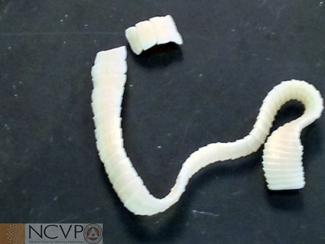

When a cat or a dog swallows the infected flea, something that is very easy to do during regular grooming, the cat or dog becomes the new host. The tapeworm egg proceeds to develop inside the flea and by the time the flea is an adult, the tapeworm can infect mammals. In pets with flea infestations, the larval fleas hatching in the area consume organic debris, flea dirt (digested blood shed by adult fleas–it looks like pepper) and any tapeworm eggs. The egg must develop further before it can infect a mammal. The good news is that you or your other pets cannot get tapes from the segments being passed by your infected pet. When the sac breaks, the eggs inside are released. Segments that have dried up look like sesame seeds. The segments look like small grains of rice and are able to move.

The sac is passed out through the host’s digestive tract. By the time the tail segments drop off, they are mostly just an egg sac. The tapeworm that infects cats and dogs, Dipylidium caninum, is a member of a large group of parasitic flatworms called cestodes. A fully mature adult tapeworm consists of the head segment, a neck segment, and multiple tail segments. Fleas are also a vector for many conditions, including infestation with tapeworms. That's why it's critical to kill fleas quickly.īut.it gets worse.Fleas on your pet are more than an itchy annoyance. And within 24 hours of its first blood meal, a flea can begin laying eggs! Egg production can reach a rate of 40–50 per day 1, resulting in an infestation. Because fleas are so tiny, you might not even see them! An unseen flea can begin feeding on your dog or cat within seconds.

Fleas can make your pet itch and cause considerable discomfort.


 0 kommentar(er)
0 kommentar(er)
